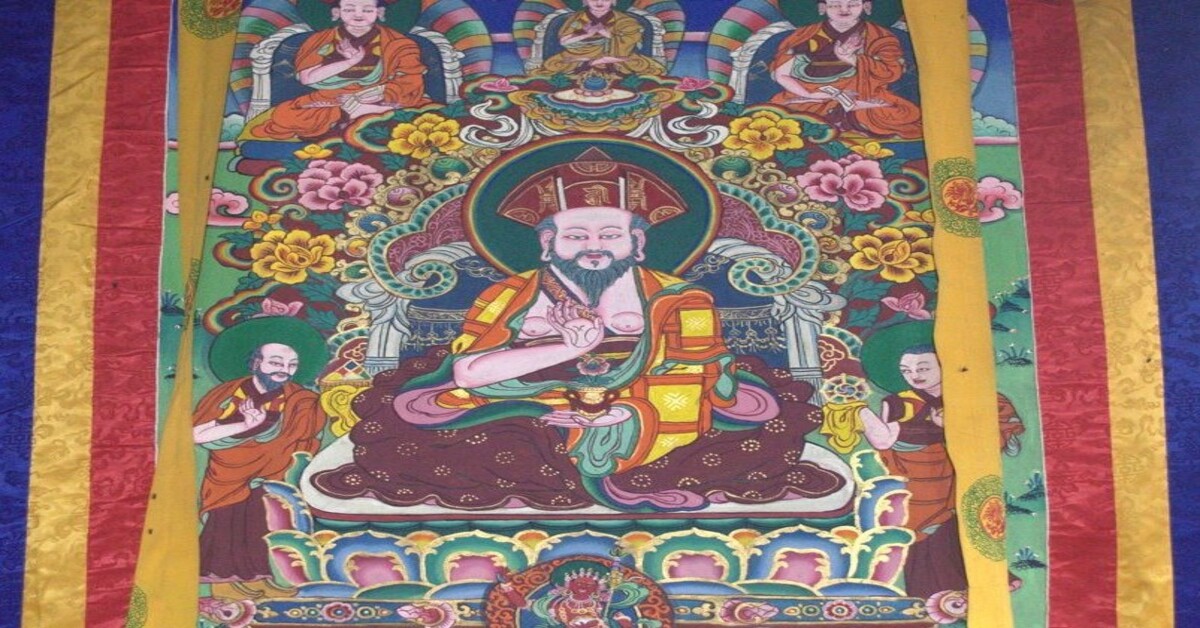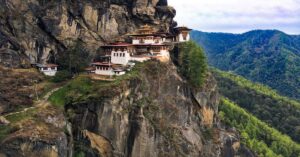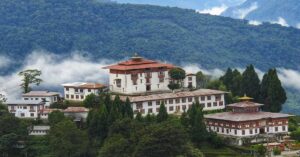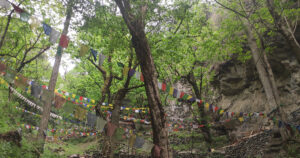Zhabdrung Ngawang Namgyal, also known as Zhabdrung Rinpoche, was a spiritual master of the Drukpa Lineage and the unifier of Bhutan. Ngawang Namgyel came to Bhutan in 1616 at 22 years of age, and later received the title Zhabdrung Rinpoche, which means “at whose feet one submits.”
Why is Zhabdrung Ngawang Namgyel regarded as an important figure in Bhutan? Zhabdrung Ngawang Namgyal is regarded as an important figure in Bhutan because he unified the country’s warring regions into a single nation-state, established the unique dual system of governance blending spiritual and secular authority, and introduced a unified legal code. He also promoted the Drukpa Kagyu Buddhist tradition, built iconic dzongs (fortresses), and laid the foundations for Bhutan’s distinct national identity and enduring stability.
He is also revered as Bhutan’s third most significant figure, after Buddha Shakyamuni and Guru Padmasambhava. So, here’s Zhabdrung Ngawang Namgyel’s story:
Early Life of Zhabdrung Ngawang Namgyal- Birth and Enthronement at Ralung
Zhabdrung Ngawang Namgyal was born in 1594 at Ralung Monastery in Tibet.
Ngawang Namgyal was born in 1594 at Ralung Monastery in Tibet to his father, Mipham Tenpai Nyima, the lineage holder of the Drukpa Kagyu, and his mother Sonam Pelgyi Butri. At a very early age, he was enthroned as the 18th Drukpa Lineage holder of Ralung and recognized as the incarnation of Kunkhyen Pema Karpo.
But his recognition and enthronement faced opposition from Lhatsewa Ngawang Zangpo, a prominent disciple of Kunkhyen Pema Karpo, who advocated for a rival candidate—Gyalwang Pagsam Wangpo, an illegitimate son of the Chongje king, Ngawang Sonam Dragpa. The Chongje king convinced Karma Phuntsok Namgyal, the Tsang king, one of Tibet’s most influential provincial leaders, to recognize Pagsam Wangpo as Kunkhyen Pema Karpo’s reincarnation. They enthroned Pagsam Wangpo as the reincarnation of Kunkhyen Pema Karpo.
However, Ngawang Namgyal remained as the legitimate throne-holder at the Drukpa Lineage throne of Ralung Monastery, regardless of who was considered the reincarnation of Kunkhyen Pema Karpo.
From Tibet to Bhutan- Arrival of Zhabdrung Ngawang Namgyal
Following a misunderstanding between Zhabdrung and his rivals, the powerful Tsang Desi demanded that the sacred relics from Ralung, including the Rangjung Kharsapani, be surrendered to the rival Pagsam Wangpo. But Ngawang Namgyal refused to return the holy relics, and Tsang Desi decided to send military forces to apprehend him.
During this time, Ngawang Namgyal had an auspicious dream of a raven flying southward, which he interpreted as a sign from Mahakali, a guardian deity of Bhutan. At the invitation of Hobtsho Lam, Zhabdrung left Tibet and traveled southward with the holy relic, Rangjung Kharsapani, fearing imprisonment in 1616. Zhabdrung Ngawang Namgyal came to Bhutan at the age of 22. Therefore, his journey from Tibet to Bhutan is regarded as the fulfillment of several prophecies, one of which is attributed to Padmasambhava:
“Seek out repose in the Southern Valleys,
On the border, through the Southern Door;
If you do thus, you will gain as much success in seven days of
meditation as in seven years in the land of Tibet.”
Gasa
Zhabdrung eventually arrived in Laya after navigating harsh mountains, hills, and valleys. There, Hobtsho Lam, who was close to his family, and the residents of Laya, welcomed him. He stayed three nights in Chongra village of Laya. Some homes in Laya still proudly exhibit the gifts presented to them by Zhabdrung, which include rare stones, pots, shoes, and other items.
Soon, Tsang Desi Phuntsho Namgyal learned of Zhabdrung’s whereabouts, and he sent soldiers to kill Zhabdrung. When the Tibetan forces reached Laya, Zhabdrung transformed all the surrounding trees into the Bhutanese army with his magical powers. This illusion made the Tibetans believe that a large Bhutanese army was present, so they decided to cancel their attack and retreat. These trees can still be seen in the Chongra village and are considered sacred today.
Thimphu
From Laya, Zhabdrung traveled to Pangri Zampa Monastery in north Thimphu, built by his great-great-grandfather, Ngawang Chogyal, in the 15th century, and stayed there. He also visited Dechenphu Lhakhang, home to the guardian deity, Geynyen Jagpa Melen, to pay his homage.
Druk Choeding, Paro
Zhabdrung then traveled to Druk Choeding Lhakhang in Paro, which was also established by Lam Ngawang Chogyel in 1525. Zhabdrung Rinpoche took refuge there. However, the Tsang Desi again learned about him and sent forces to capture him. The Tibetan troops attacked the Lhakhang and were besieged. Yet, Zhabdrung was able to escape to Drela Dzong (Jela Dzong) via Hungrel Dzong with the help of locals. While staying in the Dukhang of Jela Dzong, or the Drela Samten Choekhor, Zhabdrung met Yeshey Goenpo face to face and received a prophecy that he would win the war against Tsang Desi. From Pumola, he traveled to Tango via Tshelung Ney.
Tango Monastery
From Jela, Zhabdrung traveled back to Thimphu. Mipham Tshewang Tenzin offered him Tango Choying Dzong as a place to stay. Zhabdrung meditated in a cave and performed the tantric ritual of Gempo. Within a month, with the help of his acquired powers, he killed his antagonist, Desi Tsangpa, and his queen. Consequently, while celebrating by making offerings to the Dharmapalas, he composed the “Nga Chudugma or My Sixteen Accomplishments”. Thus, Zhabdrung got enough support from the local community. He also made friends with a rich patron in Chapcha and the Raja of Cooch Bihar. They offered him many gifts.
Cheri Monastery
With support and donations from multiple sources, Zhabdrung obtained enough resources to build his base. He chose Cheri Mountain to construct his first monastic center in Bhutan. Upon completing Cheri Monastery, he established the first monastic community of 30 monks in 1623.
Following these endeavors, Zhabdrung entered a three-year retreat in the cave above the monastery to contemplate his future. He had two choices: to wander and meditate in obscurity as a solitary mountain hermit or to establish a new religious state.
While meditating, the prophetic guidance from the sacred image of Avalokitesvara and dream encounters with his late father convinced Zhabdrung to found a new religious state. In the eleventh month of the Wood-Ox year (1625/26), Zhabdrung emerged from the cave and announced his decision to establish a new government in the country governed by uniting religion and secular government in a single administrative system.
Soon, Zhabdrung’s teachings, deeply rooted in Buddhist philosophy, resonated with local communities, providing spiritual guidance and fostering a shared purpose. The people embraced him as their spiritual leader. Zhabdrung earned the trust and respect of the Bhutanese people. This paved the way for his transformative role in unifying the nation and establishing its unique cultural identity.
Unification of Bhutan by Zhabdrung Ngawang Namgyal
Bhutan was divided into numerous fiefdoms and religious sects, each governed by a different head of state for centuries before Zhabdrung’s arrival. Recognizing the need for a united country, Zhabdrung actively sought to consolidate the diverse regions under a single rule. He traveled across Bhutan to forge alliances, construct dzongs, and attend to spiritual affairs. He also strategically built dzongs as defensive strongholds to consolidate his authority. His unification of Bhutan started with the construction of Simtokha Dzong, the first dzong in Bhutan, in 1628.
Simtokha Dzong
Zhabdrung Ngawang Namgyal constructed Simtokha Dzong at the entrance to the Thimphu Valley to exert his control over the traffic between the powerful Paro Valley to the west and the Trongsa Valley to the east. However, Lam Kha Nga and his followers resisted Zhabdrung’s unification of Bhutan. They attacked the dzong in collaboration with an invading Tibetan army.
Zhabdrung faced another attack on the dzong in 1630 by the Tibetan forces. During this attack, Zhabdrung fled to Punakha and resided in Jarogang village, ready to leave for India if he lost the war against the enemies. However, during the invasion, a part of the dzong caught fire, killing all the invading forces.
Gradually, Zhabdrung Rinpoche consolidated his control over western Bhutan by constructing Punakha Dzong and Wangdue Phodrang Dzong. Additionally, in 1645 and 1646, he constructed Drukgyel Dzong and Paro Rinpung Dzong to fortify Paro valley against potential Tibetan invasions. He also built Tashichoe Dzong and Gasa Dzong in the western region.
Eventually, Zhabdrung Ngawang Namgyal unified Bhutan by conquering central and eastern Bhutan through the construction of Trongsa Dzong, Dagana Dzong, Zhemgang Dzong, and Trashigang Dzong.
Dual System of Governance
The system of government introduced by Zhabdrung Ngawang Namgyal is known as the dual system of governance (Chhoe-sid-nyi). Zhabdrung established a unique dual system of governance known as the ‘two-fold system’, sharing control of the country between a spiritual leader (the Je Khenpo), who presides over religious institutions, and an administrative leader (the Druk Desi), who manages administrative and political affairs.
The Legacies of Zhabdrung Ngawang Namgyal
Zhabdrung’s profound influence on Bhutanese culture and traditions continues to shape the nation’s unique identity and cultural practices, leaving a lasting impact on its laws, customs, and festivals.
Spiritual Legacy: Drukpa Kagyu Lineage
Zhabdrung Ngawang Namgyal was a spiritual luminary who played an important role in shaping the country’s religious landscape. His unwavering commitment to the Drukpa Kagyu school of Buddhism and his architectural vision had a lasting impact on Bhutanese culture and governance. He established monasteries and monastic institutions throughout the country, ensuring the transmission of the Drukpa Kagyu tradition and its core values.
Architectural Legacy: Dzongs and Lhakhangs
One of Zhabdrung’s most significant contributions is the construction of dzongs and Lhakhangs, which play a central role in Bhutanese culture and governance.
The Tshechu Tradition
Another lasting contribution of Zhabdrung Ngawang Namgyal is the establishment of the Tshechu tradition. These vibrant festivals occur annually in dzongs and monasteries throughout Bhutan. Tshechus feature masked dances that portray historical events, religious stories, and mythological figures. They serve as a means for the Bhutanese people to connect with their spiritual heritage, celebrate their cultural traditions, and strengthen community bonds.
Introduction of National Dress: Gho and Kira
Zhabdrung played a crucial role in establishing Bhutan’s national dress: the gho for men and the kira for women. He standardized this attire, ensuring that their distinctive designs and patterns became symbols of national pride and unity.
Bhutanese Laws and Customs: Codification of Laws
Zhabdrung Ngawang Namgyal codified a comprehensive legal system called Tsa Yig, which integrated Buddhist principles with traditional Bhutanese practices. This legal framework helps maintain social order, promote justice, and preserve the nation’s unique cultural values.
Zhabdrung Kuchoe, the Death Anniversary of Zhabdrung Ngawang Namgyal
At the age of 56, Zhabdrung’s health deteriorated. He made frequent trips to Chubu Tshachu in hopes of restoring his health, but in vain. In 1651, he retreated to the Machen Lhakhang of Punakha Dzong, issuing instructions that no one should disturb him. It is believed that he passed away on this day, the 10th Day of the 3rd Month of the Bhutanese calendar.
However, to prevent a dynastic struggle and a return to warlordism, the governors conspired to keep Zhabdrung’s death a secret for fifty-four years. They issued orders in his name during this time, claiming he was in an extended, silent retreat until 1705.
Today, Zhabdrung Kuchoe, or the death anniversary of Zhabdrung Ngawang Namgyal, is observed annually on the 10th day of the 3rd lunar month in the Bhutanese calendar as a national holiday.
Conclusion
Zhabdrung Ngawang Namgyal’s impact on Bhutan is immeasurable. He was a historical figure, an architect, and the nation’s founder. His vision, leadership, and spiritual teachings continue to shape Bhutan’s distinct identity as an independent Buddhist nation.
Frequently Asked Questions
Family Tree of Zhabdrung Ngawang Namgyel
Zhabdrung Ngawang Namgyel’s family tree is rooted in the Drukpa Kagyu lineage of Tibetan Buddhism. His father, Mipham Tenpa’i Nyima (1567–1619), was the son of Drukpa Mipham Chogyal.
Who invited Zhabdrung to Bhutan?
Zhabdrung Ngawang Namgyal was invited to Bhutan by Hobtsho Lam, a Bhutanese leader who wanted to strengthen the Drukpa Kagyu in Bhutan.
Why did Zhabdrung come to Bhutan?
Zhabdrung Ngawang Namgyal came to Bhutan primarily to escape political persecution and rivalry in Tibet. He faced opposition and threats to his life due to conflicts over religious leadership within the Drukpa Kagyu lineage, particularly a dispute with a rival Karma Kagyu lama and the Tsang Desi’s demand for religious relics, which led to plans to arrest him.
Why is Zhabdrung Ngawang Namgyel regarded as an important figure in Bhutan?
Zhabdrung Ngawang Namgyal is regarded as an important figure in Bhutan because he unified the country’s warring regions into a single nation-state, established the unique dual system of governance blending spiritual and secular authority, and introduced a unified legal code. He also promoted the Drukpa Kagyu Buddhist tradition, built iconic dzongs (fortresses), and laid the foundations for Bhutan’s distinct national identity and enduring stability.
Which of the following was introduced by Zhabdrung?
Zhabdrung Ngawang Namgyal introduced several foundational systems and cultural elements in Bhutan. The most significant introductions by Zhabdrung include: Unification of Bhutan, Construction of Dzongs (Fortress-Monasteries), Dual System of Government (Chhoe-sid-nyi), Codification of Laws, Bhutan’s national dress, and many more.
Why did Zhabdrung Ngawang Namgyal introduce Driglam Namzha?
Zhabdrung Ngawang Namgyal introduced Driglam Namzha to unify Bhutan culturally and politically by establishing a system of disciplined behavior and cultural norms that would define and preserve Bhutanese identity and social harmony.
Who killed Zhabdrung?
Zhabdrung Ngawang Namgyal is believed to have died around 1651, with some accounts suggesting he died naturally or possibly from food poisoning during a trip to Chubu Tshachu in Punakha. There are also speculations about a possible murder, but no conclusive evidence identifies a specific killer. Regarding later Zhabdrung incarnations, the 7th Zhabdrung, Jigme Dorji, was rumored to have been assassinated in 1931 near Talo monastery. However, the exact perpetrators remain unclear.
Zhabdrung Ngawang Namgyal’s reincarnation
Zhabdrung Ngawang Namgyal’s reincarnation was identified as “mind,” “speech,” and “body” emanations. The principal reincarnation lineage, known as the Zhabdrung Thuktrul (“mind” reincarnations), includes a series of recognized incarnations from the late 17th century to the present, with the 10th incarnation born in 2003.
Enjoyed reading this blog?




